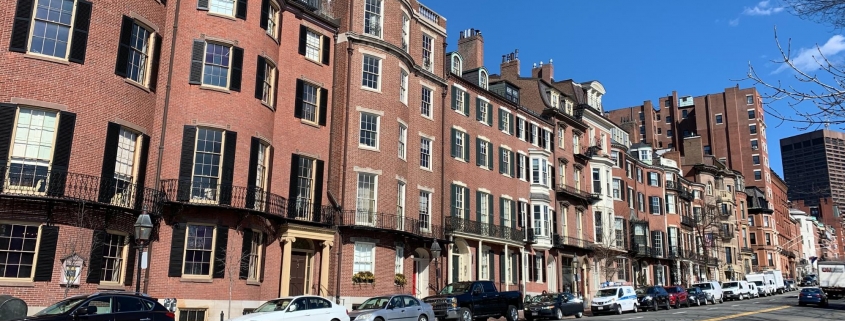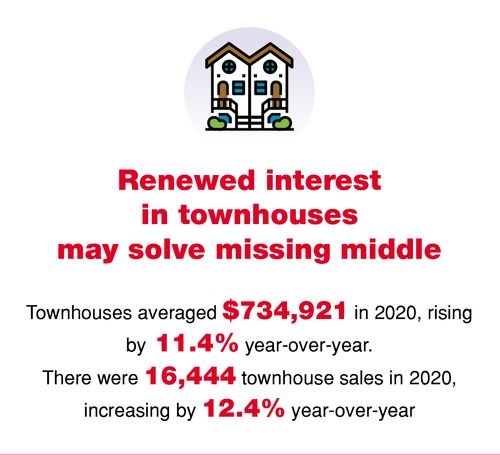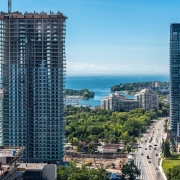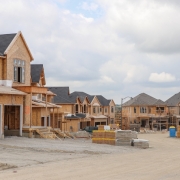Voracious demand for detached houses returned to Canada’s housing market last year, and just as in years past, unlucky buyers settled for townhouses.
“The reason the townhouse has become more popular than ever in the new construction world is, whether they’re traditional, stacked or back-to-back, they’re less expensive than detached homes, which average more than $1 million in the GTA,” said Mark Cohen, managing partner of The Condo Store in Toronto. “As a result of prohibitive pricing for detached houses, which hiccupped a couple of years ago but bounced back, and because there’s a general shortage of housing, townhouses have come into greater focus as an alternative.”
Townhouses came back into focus in 2020 because the COVID-19 pandemic trapped people, many of whom lived in condos, inside their homes for months, and when the Bank of Canada dropped interest rates, they saw their opportunity to buy a larger home. Unfortunately, the chance to borrow cheap money attracted homebuyers previously priced out of the detached market, and those unable to buy them alternatively sought townhouses.
The average price of a detached house in the GTA was $1,150,529 last year, which increased by 13.2% from 2019, according to the Toronto Regional Real Estate Board (TRREB). Conversely, townhouses averaged $734,921, rising by 11.4% year-over-year. Condominiums, which are significantly smaller than townhouses, averaged $629,491 last year.
“Townhomes always offered, on a price per square foot basis, much better value than condos, which are designed with the highest amount of efficiency and lack of wasted space,” said Cohen. ”But part of that is driven by the fact that they’re expensive—for example, the costs of concrete and underground parking are expensive, and because you spend $900-1,500 psf on a condo, certain things you might find in a house, like storage, become expensive.
“Townhouses often give you more anti-space and transitional space, and that’s closer to living in a detached home than an apartment. As a result, space is less expensive and you effectively get more for less. From a spatial perspective, townhomes offer more for less, and from a maintenance fee perspective they could be zero or negligible. There are no real expenses associated with amenities.”
Investors have also turned their attention to townhomes because they noticed the pandemic sparked desire in people for more space, and just as there are only so many detached houses for sale, there are even fewer townhouses—there were 46,359 detached sales in the GTA last year, but only 16,444 involving townhouses.
“With more people working from home, two-storey living makes sense for a variety of reasons,” said Cohen. “Investors are keen on trends and realize townhouses make sense because they allow people to functionally live and work at home at the same time.”
A report from the Canadian Centre for Economic Analysis (CANCEA) a few year ago shone a light on the dearth of so-called missing middle housing—defined as multiplexes, semi-detached, rowhomes and townhouses—in the GTA, and according to Michael DiPasquale, a CPA and COO of Dunpar Homes, the pandemic inadvertently renewed interest in these housing types.
In fact, added DiPasquale, many developers recently nixed planned high-rise developments in favour of mid-rise boutique or stacked townhouse projects, indicating that the shortage of crucial forms of housing CANCEA warned about might finally be addressed.
“Missing middle housing is more affordable for the average person and you don’t have to deal with elevators or be downtown, which is still accessible with transit or by driving a short distance,” he said. “I would say that the missing middle question has been answered because people see the need for it and the need for more space.”
Dunpar Homes has developed many infill townhouse projects just outside Toronto’s core over the years, changing the complexion of neighbourhoods in the process, and 2020 was no different. Parts of the GTA, like south Etobicoke and Streetsville in Mississauga, are prime locations for missing middle housing because Toronto’s downtown core is nearby.
“Townhouses, stacked townhouses or semis—products for people who don’t want to be in condos and can’t afford detached—fill the gap, and it’s been an issue for years,” said DiPasquale. “COVID has ramped up focus on solving the missing middle because it’s nice to have two or three bedrooms and 1,500-2,000 sq ft as opposed to 500-600 sq ft in a condo.”








 Maziar Moini, Broker of Record - Home Leader Realty Inc.
300 Richmond St. W., #300, Toronto, ON M5V-1X2
Maziar Moini, Broker of Record - Home Leader Realty Inc.
300 Richmond St. W., #300, Toronto, ON M5V-1X2


